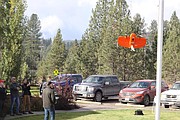High-tech equipment comes to St. Regis sawmill
This isn’t your grandfather’s sawmill. No mules dragging logs to a spinning blade powered by a smoke-belching motor.
At the Idaho Forest Group’s St. Regis sawmill high tech changes are in place or in the works, including the use of drones and a monster machine that can unload an entire log truck load in one bite.
With its primary function being that of producing 2X4s for home building, the business saw the need to increase its production capabilities while at the same time improving worker safety and comfort. The Group began a 3-phase project this past June and are well on their way to achieving those goals.
On a recent open to the public tour of the St. Regis facility, guests and media were given a firsthand look at the changes and the processes that go into producing the home-framing boards. Currently the mill produces approximately 100 million board feet of 2X4, 2X6 and 1X4 studs, as the boards are called by builders who use them. Plans are in place to add 2X3 boards to the mix.
The St. Regis mill, which was acquired by the Group in 2017, currently employs 108 workers and is seeking to fill 13 open positions.
“It’s hard to get workers these days,” said company spokesman Curt Smith. “When I first started looking for a job at a sawmill I slept outside a mill for two days before being hired.”
Phase one of the project involved shutting down and preparing for removing several pieces of equipment that were outdated including the sawmill, planer and plant boiler. Removing those huge pieces of machinery was the main focus of phase two, a project that took more than three weeks to complete. More than 4 million pounds of scrap steel was taken from the site as a result, the spokesman said.
The third phase of the project involved installing a new wood chipper, new equipment for processing residual, or waste, products, expanding storage and maintenance facilities and a new lunchroom/breakroom for employees. The mill also purchased a giant front end loader with a huge set of jaws that enable it to pick up an entire multi-ton truckload of logs in one bite.
Safety has been a key ingredient in the overall renovation process, Smith added.
“We had an incident here about four years ago where a trucker loading his empty trailer back onto his truck was fatally injured,” Smith said. “We revamped the loading area to include mechanisms that prevent such accidents.”
As for the use of drones, the company’s Drone Project manager, Aaron Fisher, showed off a new type of drone that takes off vertical, inverts to horizontal flight and uses advanced GPS data to perform its tasks. The drones capture high definition images that can be used for keeping track of lumber inventories and other things.
“This thing provides a kind of Google Earth on steroids,” Fisher said. “There’s a lot of money sitting in those log piles. This drone can inventory those piles very accurately. It uses GPA positioning to build a series of overlapping pictures as it flies above the log piles. Those pictures can then be turned into 3D images.”
And the new drone can do an inventory in about one hour, substantially less than the 24 hours it took the first generations of drones to accomplish.
Drones can also monitor forest roads to keep an eye on log trucks and provide additional data on U.S. Forest Service estimates of available timber for sale or purchase.
Most of the lumber produced by the mill is sold to large stores such as Home Depot. To help increase sales and marketing abilities, a new merchandising center is being planned at the St. Regis site.





